This self-sufficient architecture outfitted with smart technology provides a solution for our future cities!
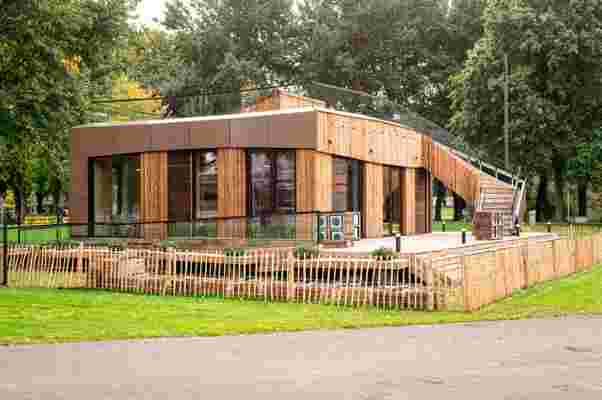
Ripple is a smart urban structure with integrated technology and self-sufficiency systems to offer a solution for the cities of tomorrow.
Taking place in Wuppertal, Germany, 2021’s Solar Decathalon Europe (SDE21) focuses on urbanization and the development of urban areas through technical and sustainable innovation . Contestant designs spanned ten categories, from social awareness to architecture. One student team from the Technical University of Eindhoven in the Netherlands, VIRTUe designed a self-sufficient housing model called Ripple.
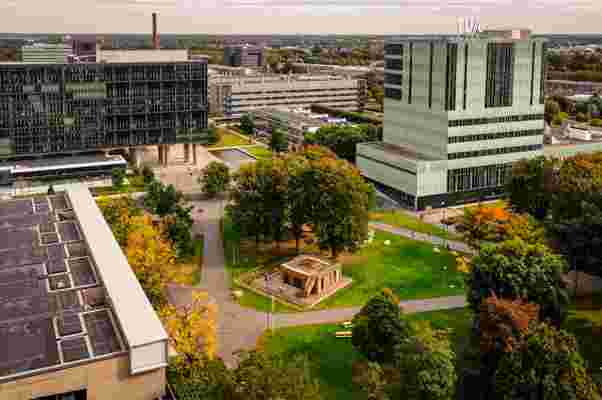
Competing against 17 different teams, VIRTUe developed Ripple as one possible “[solution] for the cities of tomorrow,” 2021’s theme for SDE. The solutions produced for this year’s SDE range everywhere from renovations for pre-existing buildings in Wuppertal, standalone structures built to fill the gaps of urban fabrics, and building extensions that service to sustainably increase urban density.
Falling into the final category, Ripple is a self-sufficient apartment structure made from repurposed wood and outfitted with a solar roof that supplies power for the structure’s integrated smart technology. Modular by design, the solar roof can change orientations depending on the best angle to capture the most amount of sunlight. Designed with integrated walking space along the perimeter of the roof, the photovoltaic panels capture sunlight to create a microclimate that sustains a small collection of the region’s biodiversity.
Connecting two apartments together, a communal space functions as the structure’s stationary technical core. There, residents will find the living room and kitchen along with a digital interface that controls all of the structure’s integrated smart technology. While the technical stationary core works as the structure’s main hub, residents can configure the different room modules to fit their needs. In addition to its modular structure, Ripple saves space through furniture with built-in hidden storage compartments that free up the home’s available living space.
Elsewhere, the home’s self-sufficiency systems provide solar power for a hot water system, heat pump, ventilation mechanics, and the main smart home system EQUI. Ensuring the energy is aptly used and spread out throughout the day, EQUI uses weather forecast statistics to approximate how much energy needs to be stored for the system to operate soundly. Finally, an accompanying app Recapp connects similar smart homes with urban facilities via digital maps.
Designer: VIRTUe
This tiny home designed for off-grid living features movable copper-clad awnings for natural ventilation!
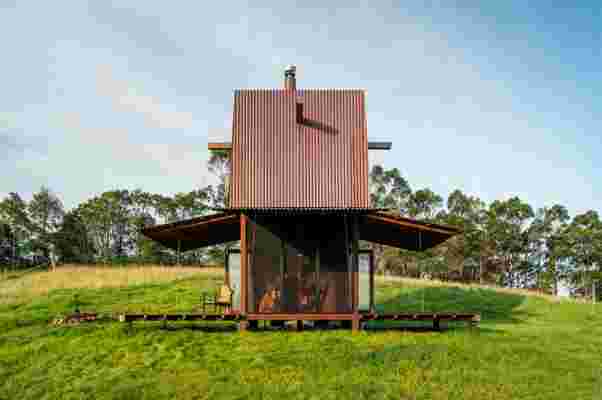
Defined by two distinct towers and movable copper-clad awnings, Permanent Camping II is a sustainable tiny home designed and constructed by Casey Brown Architects. Situated at the base of a gently sloping hill, Permanent Camping II is a prefabricated tiny house located only 500 meters away from the main house on a homestead in New South Wales, Australia.
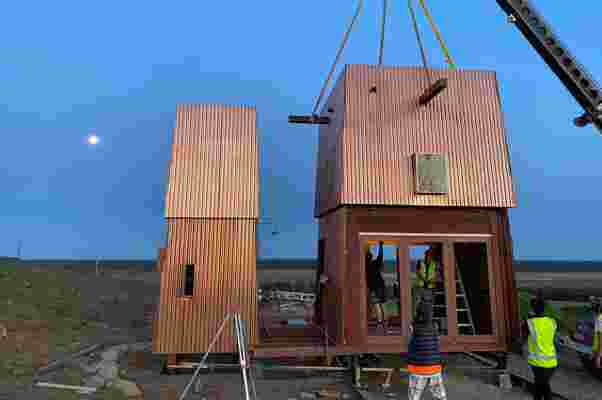
Designed and developed by Casey Brown Architecture, Permanent Camping II is a tiny house stripped-back to become a “retreat with ‘everything you need and nothing you don’t need’ with the demands of living distilled to the bare essentials.” Measuring a cozy 3×3 meters, the countryside haven leaves just enough room to accommodate two people comfortably.
Defined by two distinct towers, Permanent Camping II keeps an ironbark timber frame and a copper-clad exterior. Staving off the threat of Australian sun damage and extreme weather conditions, the copper-clad facade is built to withstand all the elements.
Since the architects behind Permanent Camping II hoped to find comfort while maintaining a small floor plan, the two towers were “designed to provide the essential requirements for a shelter, bed, porch or deck, fireplace, and bathroom.”
At ground level, Permanent Camping II’s interior leaves room for utilities required for cooking, storage capacities, and heating facilities. When homeowners would prefer a bit more living space, copper-clad awnings can unfurl from the home’s base to create a semi-outdoor living room and outdoor deck. Found right between the two towers, a ladder brings residents to the second mezzanine where the main bedroom is located.
Self-contained and sustainable, Permanent Camping II hosts a solar panel roof, water and sewage systems, and natural ventilation methods. Describing the home’s sustainable amenities in their own words, the architects at Casey Brown explain, “Water is collected on the roofs and gravity fed to the tank above the bathroom and onto the shower and kitchen. A potbelly wood-fire stove heats the cabin at night. Solar panels on the roof provide power for lighting. Permanent access is provided to the roof which doubles as a lightning conductor.”
Designer: Casey Brown Architects
From different vantage points, Permanent Camping II dons a new profile.
Come dusk, Permanent Camping II glows like a lantern.
Just behind the main living tower, Permanent Camping II has a separate bathroom complete with sustainable sewage and water treatment systems.
The copper-clad awnings create more interior living space and a space for an outdoor deck or porch.
Inside, jalousie windows provide natural ventilation even when the awnings are winched shut.
Tokyo’s unique Blue Bottle Cafe offers a safe experience for introverts & coffee lovers!
{"title":"BLUE BOTTLE COFFEE Pop Up Cafe in Shibuya","author_name":"Yanko Design","author_url":"https://www.youtubeom/channel/UCVohuIZpji5uTdzychBxKcw","type":"video","height":"591","width":"1050","version":"1.0","provider_name":"YouTube","provider_url":"https://www.youtubeom/","thumbnail_height":"360","thumbnail_width":"480","thumbnail_url":"https://i.ytimgom/vi/ACg-HfrhWVU/hqdefault.jpg","html":"<iframe width="1050" height="591" src="https://www.youtubeom/embed/ACg-HfrhWVU?feature=oembed" frameborder="0" allow="accelerometer; autoplay; clipboard-write; encrypted-media; gyroscope; picture-in-picture" allowfullscreen></iframe>","arve_cachetime":"2022-01-06 18:36:44","arve_url":"https://youtu.be/ACg-HfrhWVU","arve_srcset":"https://i.ytimgom/vi/ACg-HfrhWVU/mqdefault.jpg 320w, https://i.ytimgom/vi/ACg-HfrhWVU/hqdefault.jpg 480w, https://i.ytimgom/vi/ACg-HfrhWVU/sddefault.jpg 640w, https://i.ytimgom/vi/ACg-HfrhWVU/maxresdefault.jpg 1280w"}
If I want to be more productive , I usually go work in a cafe to have a change of space or do a coffee run as a reward for finishing my tasks. But ever since the pandemic started, it has almost been impossible to work in a cafe but it has also become trickier to pick up coffee while making sure sanitizer doesn’t get into it! But this Blue Bottle Coffee pop-up in Shibuya, Tokyo is making that little normal part of our lives safer by creating a contactless experience to get our coffees using AI robots.
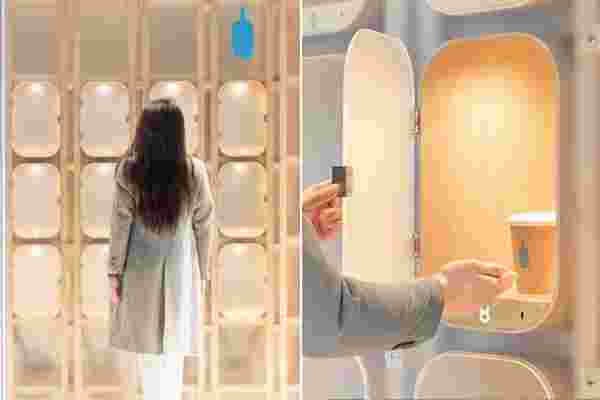
The interior architecture is designed to utilize the technology of AI cafe robot ‘Root C’ which is a service that lets you order from a screen and pick up your fresh coffee from a capsule. There are multiple slots that make up a whole wall of lockers and it almost looks like capsule hotels but tinier for your drink!
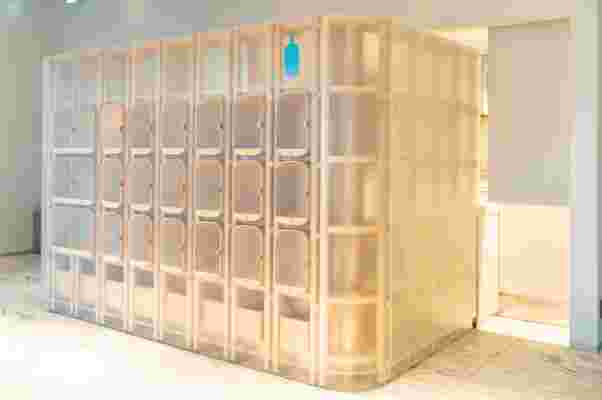
Designed by the Schema Architectural Plan, the capsules resemble a beehive . Wood is used to add warmth and translucent acrylic that covers the capsule is inspired by the glow of honey. It is designed to make you feel comfortable even if you are staying for a short time, taking home a drink.
It is a simple way to adapt to the demand for contactless service and safety while still making it a pleasant experience (especially when compared to a drive-thru!). When the barista places the coffee in the locker, the capsule glows to alert you that you can pick up your drink.
The ordering and receiving locker system is only available in Blue Bottle’s Shibuya location for now. Not only does it reduce the risk of transmission and protect people, but it is also a blessing for introverts in all circumstances – ordering without interacting with anyone.
Designer: Schema Architectural Plan, New Innovations, and Blue Bottle Coffee
Your comment